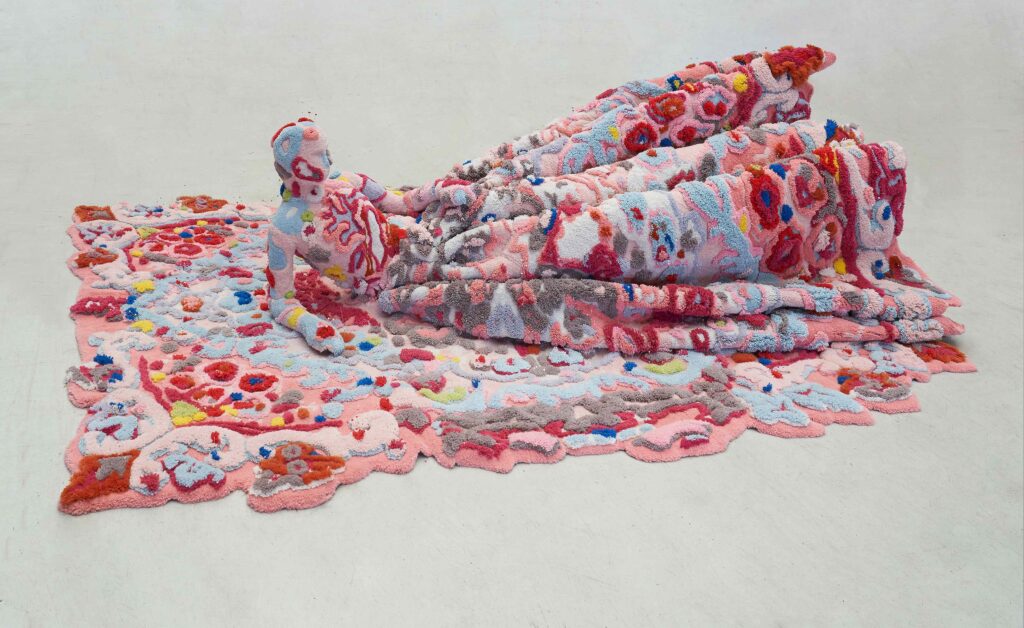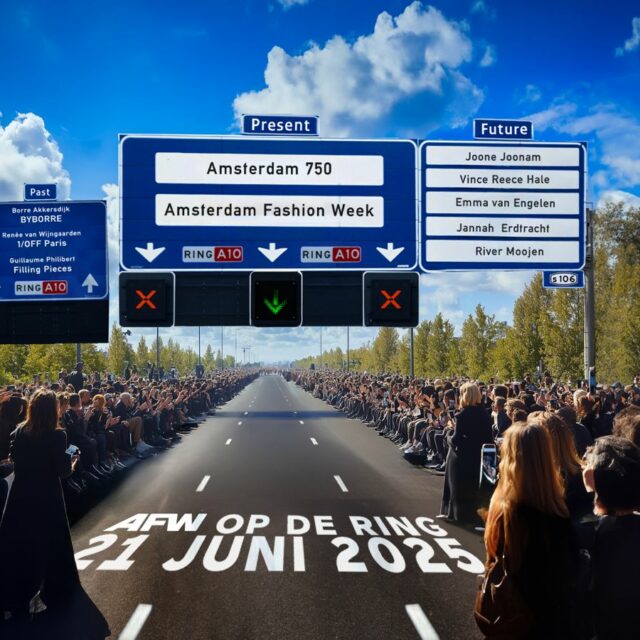Since 2022, designer Marlou Breuls swapped her namesake brand for the multidisciplinary platform House of Rubber. Shifting between sculpture and dress, jewellery and art; her rubber creations are highly sought after, her Lady in Rug was featured in every magazine with pictures of the gigantic tapestry splattered all over the internet, and her otherworldly gowns are worn by non-other than Björk. We finally had the honour of sitting down with Marlou to talk about the delightfully unusual creations of House of Rubber.
Most AFW readers know you as Marlou Breuls, the designer behind the SpongeBob-inspired Couture collection that was presented during AFW Studio 2019. How do you feel you have evolved as a designer since then?
That SpongeBob collection was only one of the odd challenges that came on my path when I graduated. After I finished my studies, I threw myself into a myriad of collaborations, as I realised I didn’t feel completely at home within the discipline of fashion. I discovered theatre and loved the performative aspect of fashion from that moment on. Combining the theatrical with fashion, the SpongeBob collaboration was right up my street. After the AFW show, I presented this collection in Poland and won a prize with it. That gave me the financial security to think about my place in the fashion industry. Then, thanks to Stimuleringsfonds, I received the talent development fund and had the time to spend the last two years really thinking about how I see my future and where my passions lie. I realised that my work is much broader than just fashion.
In 2022, you decided to continue as House of Rubber. What made you want to rebrand?
I see the rebranding as a closure of what I’ve done before, without necessarily saying goodbye to that part of my life. With House of Rubber, I take fashion and the work I’ve done in this industry into a more multidisciplinary practice. I think fashion has a performative aspect that can be applied to other disciplines as well. There is a hierarchy in the fashion industry, and I’ve always been committed not to participate in it. I want to offer the people I work with, from the students to other freelancers, a platform through House of Rubber so that they can grow. I approach everything as a group project, which is difficult because that makes me not only a designer, but also a producer and manager. I think that this way of creating however, is precisely the reason why my work is slightly different from what you would expect.
![]()
Are there similarities between your work as an artist and your work as a fashion designer?
Since I graduated, I have never been a hundred percent sure that I should have become a fashion designer. During my studies I thought this world was fantastic but when I finished, I felt the need to disconnect myself from the traditional aspect of fashion. I am an intuitive maker and I am guided by materials. Thanks to the funding I received, I had the time to delve into all the materials I wanted to learn how to work with. As a self-taught artist, the past three years I started specialising in making moulds, working with rubber, plaster, epoxy; anything but textiles, I started kneading those materials so that they would still have a relationship with fashion and the human body. I’m slowly letting go of wearable fashion, but I will always have that affinity with it. Rubber has a very versatile character. It can be soft, hard, it can be attractive, it can also repel; it has so many different functions and that is also how I see my practice now and that’s why I chose the name House of Rubber. I’m not only focused on making a dress, but also a stand-alone sculptures or installations; anything goes.
What inspired you to work with these unconventional designs and material choices?
I’ve always had a passion for liquid things. I don’t know why either. I like this chemical exploration, as if I’m working in a lab, to see what happens when I throw this and this together. I had a moment last year when I looked back at everything I was doing. I noticed then that there is a very clear connection between my work and my personality. As a person, I have a hard time making connections. I can develop relationships up until a certain point, but I find it very difficult. Therefore, I actually see my work as a kind of friendship that I can shape to my liking. That is why I always work with a triptych between the human body, the sculptural, and fashion. Lady in Rug, an installation that I recently completed, is a great example of these three elements coming together. It is an object that looks very sculptural, that is dynamic because the movement it can make. It’s worn by a representation of a human being, and there is also an undeniable dress reference. This makes for a combination that really excites me and invites others to interact with it.

Can you tell me what it was like to design for artists like Björk, Sia and Melanie Martinez? Are there any artists on your wish list that you would like to make something for?
Dressing Björk was one of the highlights of my career, so that wish list bar is set very high. I always keep her in the back of my head when I’m creating something. However, the works I make now are extensions of the body so I’m more inspired by the process and don’t have an ideal image of a person wearing what I make, where my work is presented or how it is perceived.
You just launched House of Rubber into the digital realm, announcing the arrival of a House of Rubber app. How does the digital creation process differ from the physical one?
I created the app in collaboration with 4DR studios. They approached me since they found my practice interesting precisely because of that tactility factor my work carries. We started researching how you can digitise that tactility, but also clothing in its entirety. Our collaboration has been a research project to investigate whether this is even possible. We found out that when you digitise my creations, they don’t carry the same wow factor as in real life. This however gave us a lot of insights about how the technology can improve.
The reason why we made the House of Rubber app is to make the HoR world available to everyone. The app allows you to step into the universe of House of Rubber and feel at home. You can just walk around my work and can zoom in and zoom out, which makes different from what you see in a photo. In this way, a little bit of the tactility of my work is brought to life in a digital realm. We are of course living in a time where it’s clear technology will eventually gain the upper hand, so I thought it would be interesting to investigate how this process works. Interaction was most important to me. I designed a lamp for the app that moves when you touch it, for example. I look forward to expanding this strange world even further.





